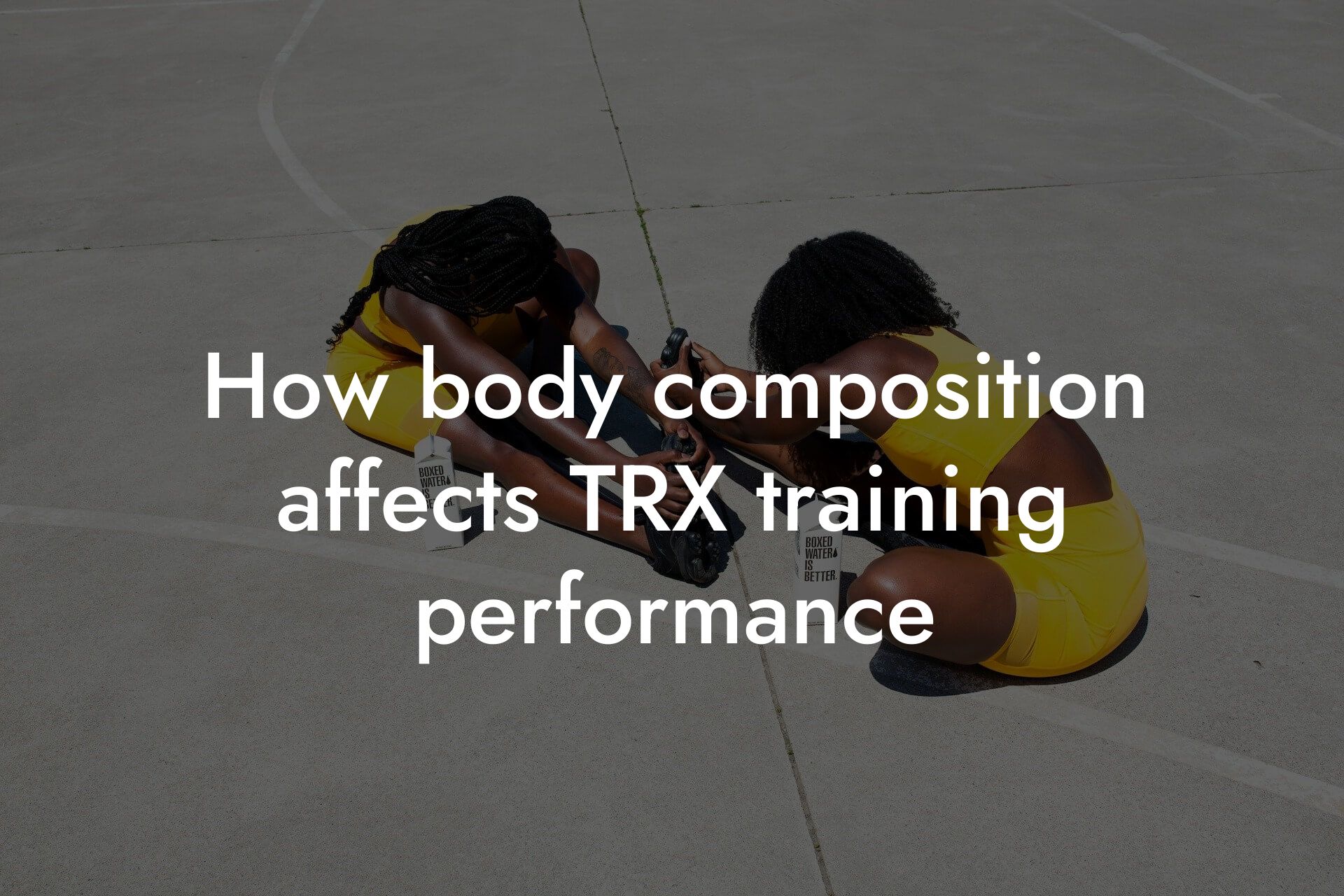As a high-earning professional, you understand the importance of maintaining a healthy and fit physique. TRX training is an excellent way to achieve your fitness goals, but it's crucial to do it safely to avoid injuries. In this article, we'll provide you with a comprehensive guide on preventing injuries during TRX training, so you can continue to perform at your best.
Table of Contents
Understanding TRX Training
TRX (Total Body Resistance Exercise) is a form of suspension training that uses your body weight and gravity to provide resistance. It's an effective way to improve strength, flexibility, and balance. However, like any form of exercise, it's not without risks. TRX training involves using suspension straps to perform various exercises, which can put stress on your joints and muscles if not done correctly.
Common Injuries Associated with TRX Training
Some common injuries associated with TRX training include:
• Shoulder strains and tears
• Wrist and elbow injuries
• Lower back strains
• Knee injuries
• Ankle sprains
Pre-Workout Preparation
Before starting your TRX workout, it's essential to prepare your body to minimize the risk of injury. Here are some tips:
• Warm up: Start with a 10-15 minute warm-up session, including light cardio and dynamic stretching to get your muscles ready for the workout.
• Stretch: Focus on stretching your major muscle groups, including your shoulders, back, hips, and legs.
• Hydrate: Make sure you're well-hydrated before starting your workout. Dehydration can lead to muscle fatigue and increase the risk of injury.
Proper Form and Technique
Proper form and technique are crucial when it comes to preventing injuries during TRX training. Here are some tips:
• Start slow: Begin with lower intensity exercises and gradually increase the difficulty as you become more comfortable with the movements.
• Focus on engagement: Engage your core and maintain proper posture throughout each exercise.
• Use controlled movements: Avoid jerky or bouncy movements, which can put unnecessary stress on your joints.
• Listen to your body: If you experience any discomfort or pain, stop immediately and modify the exercise or take a break.
Choosing the Right Equipment
Using the right equipment can make a significant difference in preventing injuries during TRX training. Here are some tips:
• Invest in a high-quality TRX system: Look for a system that is durable, adjustable, and comfortable to use.
• Adjust the straps correctly: Make sure the straps are adjusted to the correct length and tension to avoid putting unnecessary stress on your joints.
• Use grip aids: Consider using grip aids, such as gloves or grip enhancers, to improve your grip and reduce the risk of slipping.
Cooling Down and Recovering
Cooling down and recovering after your TRX workout is just as important as the workout itself. Here are some tips:
• Stretch: Take the time to stretch your major muscle groups after your workout to help reduce muscle soreness and improve flexibility.
• Foam roll: Use a foam roller to help reduce muscle tension and improve circulation.
• Rest: Allow your body time to rest and recover between workouts. Aim to take at least one or two rest days per week.
Working with a Personal Trainer or Coach
Working with a personal trainer or coach can be beneficial in preventing injuries during TRX training. Here are some benefits:
• Customized workout plans: A trainer or coach can create a customized workout plan tailored to your fitness level and goals.
• Proper form and technique: A trainer or coach can provide guidance on proper form and technique to ensure you're performing exercises correctly.
• Injury prevention: A trainer or coach can help you identify potential injury risks and provide modifications or alternatives to exercises that may be causing discomfort.
Additional Tips for Injury Prevention
Here are some additional tips to help prevent injuries during TRX training:
• Listen to your body: If you experience any discomfort or pain, stop immediately and modify the exercise or take a break.
• Start slow: Gradually increase the intensity and difficulty of your workouts to avoid pushing yourself too hard.
• Stay focused: Avoid distractions during your workout, such as using your phone or chatting with friends.
TRX training can be an effective and fun way to improve your fitness, but it's crucial to do it safely to avoid injuries. By following the tips outlined in this article, you can minimize the risk of injury and get the most out of your TRX workout. Remember to always prioritize your safety and listen to your body. With proper preparation, form, and technique, you can achieve your fitness goals and maintain a healthy and fit physique.
At Tano Performance Group, we understand the importance of maintaining a healthy and fit physique. Our DEXA machine provides a comprehensive body assessment, giving you the information you need to take your fitness to the next level. Contact us today to learn more about our services and how we can help you achieve your fitness goals.
Frequently Asked Questions
What is TRX training and how does it benefit my physique?
TRX training is a form of suspension training that uses your body weight and gravity to provide resistance. It's an excellent way to improve your overall physique, increase strength, flexibility, and balance. As a high-earning professional, incorporating TRX training into your fitness routine can help you achieve your body goals, whether it's losing body fat, building muscle, or improving bone density.
What are the most common injuries associated with TRX training?
Common injuries associated with TRX training include shoulder strains, wrist sprains, elbow injuries, and lower back strains. These injuries often occur due to poor form, overexertion, or inadequate warm-up and cool-down routines.
How can I prevent shoulder injuries during TRX training?
To prevent shoulder injuries, focus on maintaining proper form and engage your core muscles to support your shoulders. Avoid arching your back or letting your shoulders hunch forward. Start with lighter exercises and gradually increase the intensity as you build strength and endurance.
What are some common mistakes that can lead to wrist sprains during TRX training?
Common mistakes that can lead to wrist sprains include bending your wrists excessively, using too much weight, or failing to warm up properly. To prevent wrist sprains, keep your wrists straight, use lighter weights, and focus on slow, controlled movements.
How can I modify TRX exercises to accommodate existing injuries or limitations?
If you have an existing injury or limitation, it's essential to modify TRX exercises to avoid exacerbating the issue. For example, if you have a shoulder injury, you can replace exercises that involve heavy lifting with lower-impact alternatives. Consult with a fitness professional or doctor to develop a customized workout plan that suits your needs.
What is the importance of warming up before TRX training?
A proper warm-up is crucial before TRX training to prevent injuries and prepare your muscles for exercise. A dynamic warm-up, including light cardio and mobility exercises, can increase blood flow, reduce muscle tension, and improve flexibility.
How long should my TRX workout sessions be?
The ideal length of a TRX workout session varies depending on your fitness goals and current fitness level. For beginners, 20-30 minute sessions are recommended, while more experienced individuals can aim for 45-60 minute sessions. Remember to include rest days and active recovery to avoid burnout and prevent injuries.
What are some essential safety precautions to take during TRX training?
Essential safety precautions include using a sturdy anchor point, ensuring proper equipment setup, and exercising with a partner or spotter. Additionally, listen to your body and stop immediately if you experience any discomfort or pain.
Can I do TRX training if I'm a beginner?
Absolutely! TRX training is suitable for beginners, and it's an excellent way to improve overall fitness and physique. Start with beginner-friendly exercises, focus on proper form, and gradually increase the intensity as you build strength and confidence.
How can I incorporate TRX training into my existing workout routine?
You can incorporate TRX training into your existing workout routine by replacing traditional exercises with TRX alternatives or adding TRX exercises to your current routine. For example, you can replace dumbbell rows with TRX rows or add TRX squats to your leg day.
What are some common misconceptions about TRX training?
Common misconceptions about TRX training include the idea that it's only for advanced fitness enthusiasts or that it's too easy. In reality, TRX training is suitable for all fitness levels, and it can be modified to suit individual needs and goals.
How can I prevent lower back strains during TRX training?
To prevent lower back strains, maintain proper form, engage your core muscles, and avoid arching your back or twisting excessively. Focus on slow, controlled movements, and avoid bouncing or jerking motions.
What are some signs that I may be overexerting myself during TRX training?
Signs of overexertion include muscle fatigue, dizziness, nausea, or pain. If you experience any of these symptoms, stop immediately and rest. It's essential to listen to your body and pace yourself to avoid injury or burnout.
How can I cool down after a TRX workout?
A proper cool-down is essential after a TRX workout to reduce muscle tension, improve flexibility, and prevent soreness. Incorporate static stretches, foam rolling, or self-myofascial release to help your body recover.
Can I do TRX training at home or do I need to join a gym?
You can do TRX training at home with a portable TRX system or at a gym that offers TRX classes. Having a TRX system at home can be convenient, but joining a gym can provide access to expert instruction and a supportive community.
How often should I do TRX training to see results?
The frequency of TRX training depends on your fitness goals and current fitness level. For beginners, 2-3 times per week is recommended, while more experienced individuals can aim for 4-5 times per week. Remember to include rest days and active recovery to avoid burnout and prevent injuries.
What are some benefits of incorporating TRX training into my workout routine?
Benefits of TRX training include improved strength, flexibility, balance, and overall physique. It can also increase bone density, boost metabolism, and enhance mental well-being.
Can I do TRX training if I have a pre-existing medical condition?
If you have a pre-existing medical condition, it's essential to consult with your doctor or a fitness professional before starting TRX training. They can help you modify exercises to accommodate your condition and ensure a safe and effective workout.
How can I track my progress and stay motivated during TRX training?
You can track your progress by setting specific goals, taking progress photos, or monitoring your workout metrics. Staying motivated can be achieved by finding a workout buddy, joining a TRX community, or rewarding yourself for reaching milestones.
What are some common mistakes that beginners make during TRX training?
Common mistakes that beginners make during TRX training include poor form, inadequate warm-up, and overexertion. It's essential to focus on proper form, listen to your body, and pace yourself to avoid injuries and achieve optimal results.
How can I incorporate TRX training into my busy schedule?
You can incorporate TRX training into your busy schedule by finding a workout routine that suits your lifestyle, exercising during lunch breaks, or waking up earlier to fit in a morning workout. Remember, every bit counts, and even a short TRX session can be beneficial.
What are some essential TRX exercises for building strength and improving physique?
Essential TRX exercises for building strength and improving physique include TRX squats, TRX lunges, TRX rows, TRX chest presses, and TRX planks. These exercises can help improve overall strength, flexibility, and balance.
Can I use TRX training as a form of active recovery?
Yes, TRX training can be an excellent form of active recovery. It can help improve flexibility, reduce muscle tension, and promote blood flow, all of which can aid in the recovery process. Incorporate low-intensity TRX exercises into your active recovery routine to help your body recover and rebuild.
Here are some related articles you might love...
- Improving core strength with TRX training
- Using DEXA scans to monitor progress in TRX training
- How body composition affects TRX training performance
- Balancing strength and flexibility in TRX workouts
- The importance of bone density in TRX fitness
- Strength training tips specific to TRX exercises
- Reducing body fat for better TRX workout results
- Nutrition tips for sustained energy during TRX sessions
- Maintaining muscle recovery with TRX training
Zak Faulkner
Zak Faulkner is a leading authority in the realm of physical health and body composition analysis, with over 15 years of experience helping professionals optimise their fitness and well-being. As one the experts behind Tano Performance Group, Zak has dedicated his career to providing in-depth, science-backed insights that empower clients to elevate their physical performance and overall health.
With extensive knowledge of DEXA technology, Zak specializes in delivering comprehensive body assessments that offer precise data on body fat, muscle mass, bone density, and overall physique. His expertise enables individuals to make informed decisions and achieve their fitness goals with accuracy and confidence. Zak’s approach is rooted in a deep understanding of human physiology, combined with a passion for helping clients unlock their full potential through personalised strategies.
Over the years, Zak has earned a reputation for his commitment to excellence, precision, and client-focused service. His guidance is trusted by top professionals who demand the best when it comes to their health. Whether advising on fitness programs, nutritional strategies, or long-term wellness plans, Zak Faulkner’s insights are a valuable resource for anyone serious about taking their health and fitness to the next level.
At Tano Performance Group, Zak continues to lead our Content Team revolutionising how professionals approach their physical health, offering unparalleled expertise that drives real results.




